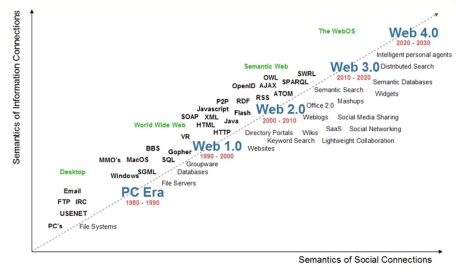Web 2.0 vs Web 3.0 March 8, 2008
Posted by Doriano "Paisano" Carta in Semantic Web, Web 2.0.Tags: Semantic Web, Web 2.0, Web 3.0
12 comments
Web 2.0 is still alive & kicking but everyone is already focussing on Web 3.0. What is Web 3.0? Well, the old adage is true: a picture is worth a thousand words. With that said, I will let the following images and videos explain the differences between web 2.0 and web 3.0 otherwise known as the Semantic Web.
In the Beginning there was Frontpage
Before comparing Web 2.0 and Web 3.0, it might be helpful to compare Web 1.0 with Web 2.0 first. Here’s an excellent image that does a great job showing the differences:
Here’s a visual comparison of all three: web 1.0, web 2.0 and web 3.0
Here’s a straight forward explanation
Tim O’Reilly’s definition
Tim Berners Lee on Web 3.0/Semantic Web
Digital bazar’s explanation of the Semantic Web
Here’s a video showing the history of web 1.0 to present and beyond to web 4.0!
Final Thoughts:
No matter what the terms or how things are explained, one thing is certain: the future of the Internet and technology is extremely exciting! Things will only continue to evolve into more collaborative and personal ways which is great for everyone on a personal and professional level.
By the way, this isn’t the first time that Web 2.0 was given its last rites! Nicholas Carr called Web 2.0’s time of death on 11/11/06!
![]()
Web 3D January 23, 2008
Posted by Doriano "Paisano" Carta in Virtual Worlds.Tags: 3D Virtual Worlds, Web 3.0
1 comment so far

Everyone’s talking about Web 3.0 or the Semantic Web these days, but I think a more accurate name might be Web3D because the future of the internet will involve more 3D virtual reality and the metaverse. The internet will continue its natural evolution of becoming increasingly more visual and interactive. Artificial Intelligence will also become more evident in our web experience.
Wells Fargo has been one of the innovators when it comes to offering their services in a virtual world. Here is their Stagecoach Island in SecondLife where customers can walk around their premises and actually interact with others and even conduct business in a whole new way. They’ve already announced plans to offer Stagecoach Island jobs, credit cards and loans as a way to learn more about money management and earn more virtual money so that you can build and play more in the real world. Look for many other brick and mortar businesses to emulate the blueprint that Wells Fargo has developed over the years with their virtual world.
Forterra Systems actually creates virtual worlds for corporate, healthcare, government and entertainment industries. Their OLIVE (Online Interactive Virtual Environment) technology has allowed them to build realistic training grounds and virtual businesses. Here is an interesting video that shows what they can do.
Virtual Support
It is becoming increasingly common to get instant live support on websites whenever you have a sales or technical question thanks to services like LivePerson. While this real-time live assistance is a step in the right direction, it is still a cold impersonal web 1.0 text-based interaction. In the near futue, look for companies to provide 3D virtual sales and support assistance in the form of avatars (virtual representatives) to their website visitors. This might look something like this from Zoki at first, but the appearance of the virtual assistants will become more realistic as they have in some of the popular 3D virtual worlds we use today.
Seeing is Believing
If you are curious about the shape of things to come, then checkout some of the 3D virtual worlds that exist today for free. Here is a rundown of just some of the most popular 3D Virtual Worlds today.
SecondLife is the most well-known and popular 3D world. They continue to push the envelope when it comes to bridging the gap between our current 2D web and the future of Web 3D Virtual Reality. They’ve failed at several attempts to incorporate business and commerce within their virtual worlds but who is to say that they won’t eventually find the winning formula? I admire the attempts and the “outside the box” thinking they continue to share with the world.
Worlds has been around longer than any other virtual world service. I personally got hooked on this in 1999/2000, long before there was a SecondLife. They’ve only recently launched a major upgrade that will allow it to compete with SecondLife which has surpassed it as the most feature rich virtual world. Still, Worlds cannot be forgotten as one of the pioneers of the metaverse. They were the first to attract big names to the platform and created BowieWorld (Davie Bowie themed world) and Aerosmith World. They also had well-known locations built such as Yankee Stadium which allowed you to walk all around the famous arena. Here’s a video of the new Worlds.com.
Croquet is an open source 3D world and development platform. Expect big news from this service as it gains traction within the development community. The posibilities are endless! Here’s a demo video of what it can do:
TheSims is the legendary world that you cast the characters and watch, sort of like virtual seamonkeys. The amount of characters, worlds and options continues to grow in impressive fashion. Still, it isn’t the first person type of virtual experience that SecondLife offers.
World of Warcraft is the well-known and ultra successful role playing game that allows you to create a virtual character and interact with others online. The number of monthly subscribers is staggering and WoW has been profitable for a long time. Their business model is studied by all interested in virtual worlds.
Entropaiuniverse is like a cross between World of Warcraft and SecondLife.
Multiverse is another open source 3D world development platform. There is debate over how open this platform truly is or not.
ActiveWorlds is similar to Worlds.com. You can create your own avatar and build your own homes and worlds.
RedLightCenter is like SecondLife for adults only due to its sexual themes and language.
Kaneva is unique because it offers not only the 3D chat experience but also a 2D chat to bridge the gap between worlds.
There offers the usual features. Coca Cola has a virtual world there.
VSide is called the 3D facebook.
Zwinky is a popular 2D world for teens and pre-teens
Gaia is another preteen favorite.
Hipihi is a visually stunning experience from China.
Meez isn’t a 3D world but a way to create your 3D profile.
CityPixel is a 3D isometric (pixel-art) city where users can stake a claim on some virtual real estate (apartments/office cubes) for free.
Final Thoughts
Will 3D Virtual Worlds really be a significant part of Web 3.0 (Semantic Web)? I doubt it, but I do believe that it will play a much bigger role in our every day web experience. I firmly contend that it is a natural evolution of the Internet to become increasingly more visual and thus more realistic and thus more interactive. One need only examine the evolution of computer games to see the same pattern developing with our online experience. Where websites from 1994 on Netscape Navigator are like the game of PONG and today’s ultra realistic worlds on SecondLife are like Halo 3. Perhaps not the best analogy but you get the picture (pun intended).
Please bookmark the live Virtual Worlds Matrix document that will maintain an exhaustive list of all virtual worlds as they come and go and evolve.
Update: 20 tools for enhancing virtual experience from Mashable













